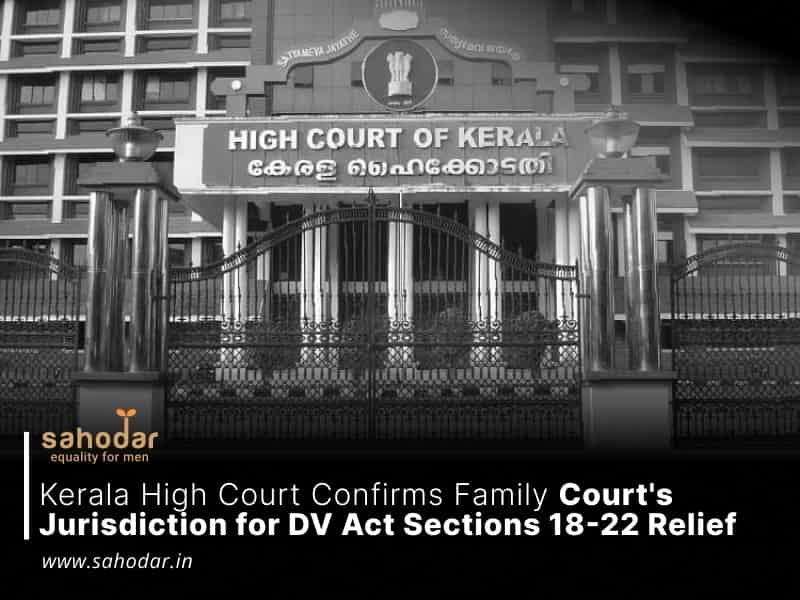The Kerala High Court has established that the Family Court is legally empowered to consider a petition seeking remedies under the Protection of Women from Domestic Violence Act, 2005
“What is discerned from the provisions of Section 12 is that an aggrieved person is free to elect any of the reliefs. The legislature in the wisdom has framed the Act by taking into consideration the doctrine of election. The parties are free to elect either a remedy under Section 12 or reserve the right to claim other reliefs as provided under Sections 18, 19, 20 and 21 in the manner and mode as has been done. The plain and simple reading of the provisions of Section 26 left the question clear and unambiguous that a party seeking a claim under any provisions of the civil or criminal court much less a family court can always claim relief in addition as provided under Sections 18, 19, 20, 21 and 22 of the Act,” the Division Bench comprising Justice Amit Rawal and Justice C.S. Sudha explained.
This legal matter concerns the initiation of original divorce petitions by the petitioner-husband and the respondent-wife in the Family Courts of Alappuzha and Ernakulam, Kerala. Simultaneously, the respondent also filed separate petitions under the aegis of the Protection of Women from Domestic Violence Act, 2005 (‘DV Act’) in the Ernakulam Family Court.
The petitioner consistently contended that the Family Court in Ernakulam lacked the requisite jurisdiction to entertain these DV Act cases. In response, the petitioner sought redress in the High Court, contending that, in accordance with Section 12 of the DV Act, exclusive competence for addressing petitions under the DV Act was vested in the Judicial Magistrate.
Section 12 of the DV Act grants an aggrieved person, a Protection Officer, or another duly authorized individual the prerogative to file an application before the Magistrate, seeking one or more of the remedies delineated in Sections 18-22 of the statute. These provisions empower the Magistrate to issue a range of orders, such as Protection Orders, Residence Orders, Custody Orders, Compensation Orders, and monetary reliefs.
The petitioner argued that if the respondent could seek such remedies in the Family Court, the applicability of Section 12 of the DV Act would be rendered superfluous, thereby creating an anomalous legal situation due to the contrasting appellate procedures associated with these distinct court systems.
Conversely, the respondents posited that Section 12 affords the parties the discretion to opt for the forum in which they intend to pursue their relief, without mandating an exclusive avenue of redress.
To aid in resolving this issue, the High Court appointed an Amicus Curiae, a legal expert, who opined that the Family Court could appropriately adjudicate cases falling under the purview of the DV Act. This conclusion was grounded in the argument that the issues addressed by the DV Act primarily encompass civil matters, which align with the Family Court’s typical jurisdiction. The legal expert substantiated this viewpoint by reference to specific legal provisions.
Upon careful examination of the DV Act, the Court ultimately determined that Section 12 grants aggrieved parties the discretion to elect the forum for seeking relief with respect to DV Act-related issues.
It added that Section 26 of the Act does not denude Family Court from dealing with a petition in a claim under Sections 18, 19, 20, 21 and 22 of the Act. Section 26 expressly states that, “Any relief available under sections 18, 19, 20, 21 and 22 may also be sought in any legal proceeding, before a civil court, family court or a criminal court, affecting the aggrieved person and the respondent whether such proceeding was initiated before or after the commencement of the Act”.
It thus proceeded to declare,
“The apprehension expressed by the petitioner by submitting an application for return of the original petition, in our view is far-fetched and a figment of imagination; rather ought to have pressed the issue of maintainability and lead evidence by leaving the question open for the Trial/Family Court to decide at an appropriate stage. Similarly, the argument that the relief under Sections 18, 19, 20, 21 and 22 cannot be granted by the trial court is also untenable much less opaque, capricious and hereby rejected. The whole purpose of carving out the Family Court Act is to club various provisions by confining the jurisdiction of one court to prevent multifariousness. This is precisely what has been sought in this case”.
It thus held that the order of the trial court rejecting the application based on the appreciation of the provision was legal and justified.

